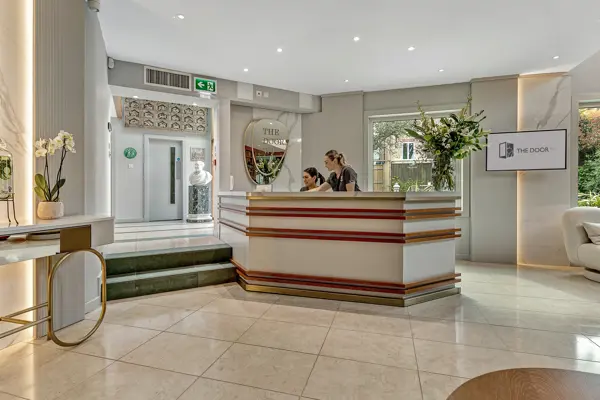
The Door W4 Clinic Shortlisted as a Finalist at the Safety in Beauty Diamond Awards 2025!
We’re excited to announce The Door W4 is a Finalist for ‘Best Clinic South England’ at the 2025 Safety in Beauty Awards!
Have you ever dreamt of achieving that elusive glassy skin? Or tightening up those parts of your face that have begun to sag over the years? Brand new AgeJet at The Door W4 seeks to address many common skin concerns, ensuring skin health and vitality.
Victoria Voysey, unveils AgeJet, a significant advancement in skincare. She states, “We were the first people to have this specific machine in the UK which is really exciting."
The AgeJet employs nitrogen plasma treatment. Victoria elaborates, “…what we do with Agejet is we use a specific handpiece where we pass radio frequency current, or radio frequency energy, and we deliver it into the skin through pure nitrogen gas. So it just literally puffs it into the skin and it feels very hot, but it's really comfortable. It's not an uncomfortable treatment to have." This method ensures a comfortable experience without the need for numbing creams.
The AgeJet technique stimulates collagen and elastin production by inducing a controlled trauma within the skin. Victoria explains, "That energy in the skin is helping to stimulate your collagen and elastin production. It causes a controlled trauma on the skin which really helps to activate your body's natural response mechanism." Over time, this controlled response yields skin improvements.
The AgeJet offers a two-pronged advantage of skin tightening and resurfacing, without the need for more ablative laser treatments. "By increasing that collagen production, you get skin tightening... You also get a resurfacing effect from the treatment. So you get this lovely kind of glowy texture to the skin," remarks Victoria.
Moreover, the treatment is adept at addressing a variety of skin conditions. Beyond addressing epidermal pigmentation, it's also found effective for rosacea, a condition Victoria mentions is "quite difficult to treat."
A course of treatments maximises the results of AgeJet. As Victoria suggests, "Depending on the skin type, the skin age and the skin health you generally need around two to three treatments... about four to six weeks apart." Post-treatment, there's minimal downtime, but certain skincare products and routines should be halted to ensure best results.
Emphasising a complete understanding of the client's skin history before the AgeJet treatment, Victoria recommends prepping with Vitamin C and other specific products. She says, "Especially if you've got things like pigmentation, you really need to prep the skin... I would never just go in straight and do this on a new client. I want to make sure that I know that client's skin, that it's in good health.”
"I wouldn't want anybody using retinols on the skin at least a good few days before, if not a week before. If it was a much stronger retinol, like a Tretinoin, then I would want a bigger gap, about a two week break from it."
Adding weight to AgeJet's efficacy, Victoria shares her positive experience, "I had mine four weeks ago, and I absolutely love the results."
Victoria describes her experience with the treatment: “So after the treatment you'll be quite red. You'll have these sort of red dots all over the face and the neck area. And then over the next seven days, I generally say to clients it's about seven days of downtime, but it's not bad downtime. I still went to work and you can put makeup on after 24 hours. But over the next few days, that redness will decrease.
Then about day four or five, you'll tend to get some shedding. And by day 10 you're like, ‘wow, my skin looks really glowy.’ And then by the end of that month, You'll be thinking, ‘right, my skin is feeling much tighter, it's looking much smoother. The pores are improved.’ So it really takes a good four weeks to see a good result, but it will continuously improve over the next four to six months because you've generated that new collagen production and it can take that long for it to actually be laid down.”
What we see is that this one-off treatment can have incredible long term benefits.
In the intricate domain of skincare, AgeJet represents a methodical, evidence-based approach to skin rejuvenation. For those seeking informed and effective skincare solutions in Chiswick, AgeJet presents a promising option.
For an in-depth understanding and the complete dialogue between Victoria Voysey and Carrie Hancox, watch the full interview below.
00:00:32 – How do I get perfect skin?
00:02:11 – What does Fire and Ice treat?
00:02:45 – Where do I start with older skin?
00:03:07 – Is there a ‘holy grail’ product?
00:04:03 – How does skin change after 40?
00:06:06 – What is the most common skin concern you see?
00:06:51 – What other treatments can I have?
00:07:32 – What is AgeJet?
00:10:30 – How many AgeJet treatments do I need?
00:12:08 – How should I prepare for AgeJet?
00:13:58 – What is Retinol?
00:16:19 – What makes The Door W4 unique?
Get in touch with us for by filling out out contact form.
We’re excited to announce The Door W4 is a Finalist for ‘Best Clinic South England’ at the 2025 Safety in Beauty Awards!
We’re excited to share that Dr. Sarah Jenkins, a women’s intimate health specialist here at The Door, was recently featured on ITV’s The Price of Perfection, hosted by Olivia Attwood.
Discover how she helped a mum of two reclaim her confidence with EmpowerRF - an advanced treatment for postnatal pelvic health, intimate rejuvenation, and wellness.
We’re excited to share that Miss Natasha Berridge, Consultant Oral, Maxillofacial and Aesthetic Surgeon at The Door, was recently featured on Channel 4’s new docuseries 'Love My Face'.
Presented by campaigner and activist Jono Lancaster, the series follows individuals seeking confidence through a range of facial aesthetic treatments, delivered by top UK clinicians at a specialist clinic in Yorkshire.


